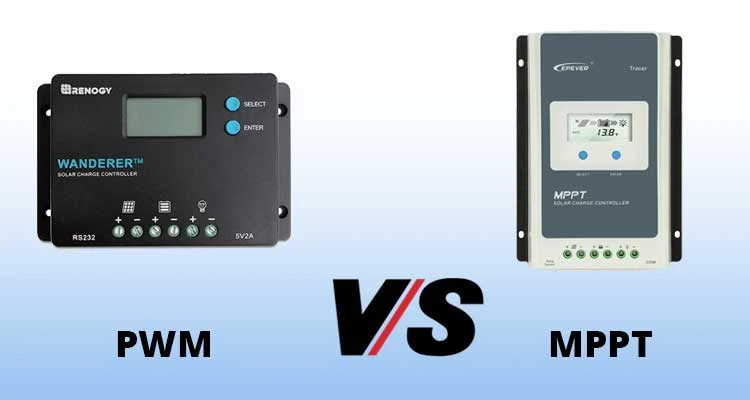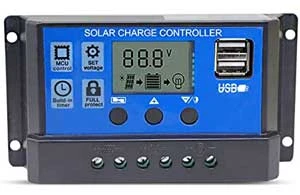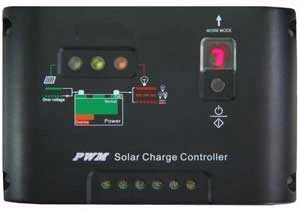by Malcolm Woods
Do you have a solar system that uses a battery for storage? Chances are that you want to be able to extend the life of the battery while making sure everything is safe.
If that is so, a solar charge controller is one piece of equipment you shouldn't overlook. It prevents the premature damage of batteries so that you can enjoy flawless power while avoiding unnecessary replacement expenses.
When shopping for a suitable solar charge controller, you might end up feeling overwhelmed by a large number of options on the market. I am here to help you out.
At the basic level, there are two major categories - PWM and MPPT controllers.
Maybe you've heard about these, but you don't have time to deal with all the technical stuff being thrown around.
Don't worry, I will break down the two types for you in a language everyone can understand.
By the time you're finished reading (in just a few minutes), you should understand clearly the PWM vs MPPT controllers.
Let's take a closer look.
Contents


Also called a solar charge regulator, this is a little device that regulates the power flowing from the panels to the batteries.
You see, each battery has a rating for the maximum voltage capacity. Without a charge regulator, the battery can get overcharged, resulting in its damage.
The main objective with a solar charge controller is to ensure the batteries are fully and optimally charged while preventing overcharging.
That way, the device helps prevent battery damage. It preserves the life of the battery for as long as possible while preventing explosions.
Before we talk about the difference between the MPPT and PWM solar charge controllers, let's quickly see what each of these entails.

PWM is an initial, standing for "power width modulation".
In the older days, solar charge regulators simply monitored the voltage of the battery and would stop the current when the voltage rose above a certain level.
With the advent of the PWM controllers, it was possible to lower the current flow slowly as the voltage approaches a certain level. That reduces the stress on the battery while ensuring it is fully charged. And that's just what the PWM controllers do.
When the battery gets fully charged, these controllers take the charge rate into a "trickle" state, where only a very little amount of current flows into the battery. That way, the battery stays topped off.
PWM controllers are more appropriate for small solar panels serving a specific purpose at home, such as powering the lights, as opposed to large systems that power the entire home.
Why ?
First, because these controllers are not designed to deal with very high voltages, which the large panels can emit.
And secondly, because with these controllers, the battery and the solar panel should have the same voltage levels. And that's the order of things with the small panels. Larger panels don't always have the same voltage with the battery they're attached to.

MPPT is also initial, standing for "maximum power point tracking".
Like the PWM controllers, these keep the voltage of the battery in check, reducing the power flow rate as the battery nears the full capacity.
But contrary to the PWM models, these are able to work with panel and battery voltages that don't match.
MPPT regulators are also versatile, capable of adjusting the flow rate up or down depending on the needs of the battery. They can make an adjustment that brings in the maximum possible power from the panels.
Also, these regulators can change excess voltage into amperage. That means the MPPT controllers are more efficient than the PWM controllers.
Note: however, that this benefit makes them costlier than the PWM controllers.
In this section, we're going to look at various areas where MPPT and PWM regulators are different and help you choose.
One of the major areas where these two controllers are different is in the voltage tolerance.
Realize that most solar panel batteries have a voltage of 12V, like most car batteries.
If you're using a PWM controller, the voltage from the solar panels has to be a little higher than that, at around 18 volts for the power to flow efficiently to the battery.
That's because there's low voltage in the wires, which can cause energy loss.
Unfortunately, PWM controllers are not designed to handle high voltages, so there's often lots of energy loss.
MPPT controllers, on the other hand, can tolerate higher voltages. As there's high voltage in the wires, there's lower energy loss.
If you're using a solar panel that puts off VOC voltages over 35v to charge 12v batteries, you want to get an MPPT unit rather than a PWM controller.
As mentioned earlier, a majority of solar panels are connected to a 12V battery for energy storage. But solar panels can deliver higher voltages than that.
MPPT controllers usually convert the excess volts into amps. That way they keep the charge voltage at an optimum. This also reduces the time needed to charge a battery to full capacity.
PWM controllers are not able to do the conversion of amps into volts. That means the charge rate is not as efficient.
Now, let's look at the benefits and drawbacks associated with each type to better understand what you're getting.
A solar charge controller is a very important device for several reasons. It regulates the flow of power from your solar panels and ensures that the battery doesn't get overcharged.
That way, it prevents the battery from getting damaged and saves you from incurring unnecessary expenses. No more getting lost in the technical lingo.
It is my hope that this guide has cleared the confusion and helped you understand what PWM and MPPT units are, as well as the difference between them.
 |
 |
 |
 |

About Malcolm Woods
Malcolm Woods is a blogger who enjoys writing about technology and solar power. He has a passion for learning new things, and loves to share his knowledge with others. Malcolm is also an advocate for sustainable living, and believes that everyone has a responsibility to do their part in preserving our planet.
 |
 |
 |
 |
Go for the FREE Gifts. Or check out for free energy books from our best collection.
Remove Ad block to reveal all the secrets. Once done, hit a button below
 |
 |
 |
 |